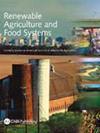城市园林的生产功能:普拉托(意大利)社会园林的产量和营养价值估算
IF 2
3区 农林科学
Q2 AGRICULTURE, MULTIDISCIPLINARY
引用次数: 0
摘要
城市菜园对粮食生产和营养供应的影响在文献中得到广泛认可,但却很少被量化。在本文中,我们介绍了在普拉托(意大利)"社会菜园 "进行的半结构式访谈的结果。"社会菜园 "是指市政府分配给养老金领取者或失业者个人用于种植供家庭消费的蔬菜的土地。对一些人口和社会经济方面、种植作物和相关区域进行了调查。从面积出发,对蔬菜总产量及其矿物质和维生素含量进行了估算。典型的园丁为男性,退休,平均年龄 74 岁,教育水平较低。园艺使养老金领取者能够利用空闲时间,促进体育锻炼,促进社交,激发自尊。一块 50 平方米的菜地有 40% 的面积用于种植蔬菜,估计每年可生产 90 公斤蔬菜,大约相当于一个人对水果和蔬菜需求量的 61.5%。番茄是最主要的蔬菜品种,占种植面积的 80% 以上。营养素摄入量最高的是维生素 C 和维生素 A,最低的是 Ca 和 Na。通过更好地利用土地(减少非耕地面积和增加蔬菜种类),很容易获得更高的产量和更多更均衡的营养供应。我们认为,提高园丁对这方面的认识,并让他们参与有关农业实践、蔬菜成分和营养的培训计划,将有助于提高地块的营养生产率,并最终加强社会菜园的生产功能。本文章由计算机程序翻译,如有差异,请以英文原文为准。
Productive function of urban gardening: estimate of the yield and nutritional value of social gardens in Prato (Italy)
The impact of urban gardens on food production and nutrient supply is widely recognized in the literature but seldom quantified. In this paper, we present the results of a semi-structured interview conducted in the ‘social gardens’ of Prato (Italy), i.e. areas of land assigned by the Municipality to individual pensioners or unemployed people for the cultivation of vegetables intended for domestic consumption. Some demographic and socio-economic aspects, the cultivated crops and the related areas were investigated. Starting from the areas, the total production of vegetables and their minerals and vitamins contents were estimated. The typical gardener was male, retired, with an average age of 74, and a low level of education. Gardening enabled pensioners to utilize their free time, facilitated physical activity, promoted socialization, and stimulated self-esteem. A 50 m2 plot cultivated on 40% of the area produced an estimated amount of 90 kg of vegetables per year, equivalent to approximately 61.5% of a person's fruit and vegetable needs. Tomato, by far the predominant species, occupied more than 80% of the cultivated area. The highest contributions to nutrients intake concerned Vitamin C and Vitamin A, the lowest Ca and Na. A higher yield and a greater and more balanced nutrient supply could be easily obtained through better use of the land (reduction of uncultivated area and greater assortment of vegetables). In our view, raising gardeners' awareness of this aspect and involving them in training programs on agricultural practices, vegetables composition, and nutrition, could be helpful for increasing the nutrient productivity of the plots and, ultimately, for strengthening the productive function of social gardens.
求助全文
通过发布文献求助,成功后即可免费获取论文全文。
去求助
来源期刊

Renewable Agriculture and Food Systems
农林科学-农业综合
CiteScore
5.20
自引率
7.40%
发文量
39
审稿时长
>36 weeks
期刊介绍:
Renewable Agriculture and Food Systems (formerly American Journal of Alternative Agriculture) is a multi-disciplinary journal which focuses on the science that underpins economically, environmentally, and socially sustainable approaches to agriculture and food production. The journal publishes original research and review articles on the economic, ecological, and environmental impacts of agriculture; the effective use of renewable resources and biodiversity in agro-ecosystems; and the technological and sociological implications of sustainable food systems. It also contains a discussion forum, which presents lively discussions on new and provocative topics.
 求助内容:
求助内容: 应助结果提醒方式:
应助结果提醒方式:


